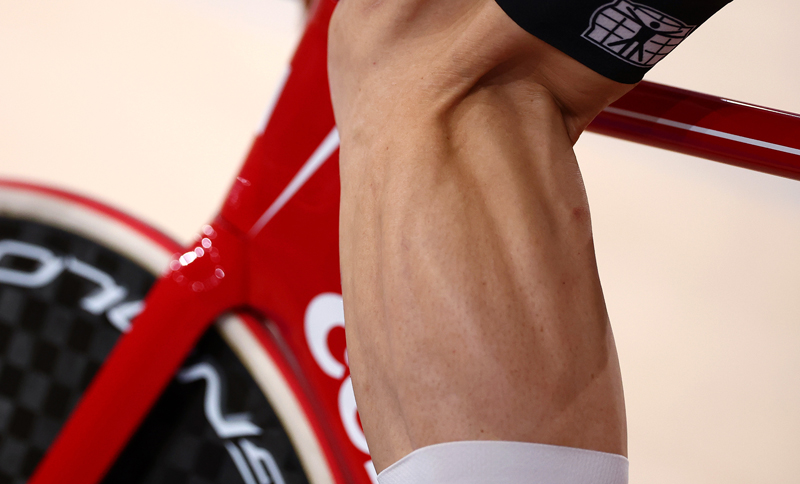You are viewing 1 of your 1 free articles. For unlimited access take a risk-free trial
BFR training: is there a perfect recipe for strength?
How effective is blood flow restriction (BFR) training for strength gains, and how can athletes ensure they get the best results? SPB looks at new research
Image courtesy of Reform Sports and Fitness - www.reformsports.co.uk
Although it sounds counterintuitive, a large body of evidence has accumulated over the past decade or so that restricting blood flow to the moving limbs during exercise – dubbed ‘blood flow restriction’ or BFR training - can produce high-loading benefits even though the exercise is conducted at a relatively low loading.
History of BFR training
Although BFR training has only recently become a topic of interest in the West, its roots go back much further. In fact, BFR training was first utilized in Japan by Doctor Yoshiaki Sato in the 1970s(1). Sato is said to have came up with the idea while he was sitting in a traditional Japanese posture, when he suddenly realized that the blood flow was restricted to his calves and his feet, and that this restriction was giving him the same burning sensation he experienced during exercise. After this revelation, Sato began experimenting, trying replicate the physiological conditions he experienced in order to produce similar results to exercising at high volumes. Once Sato’s theory demonstrated positive results, he trademarked this form of training as ‘KAATSU training’, a Japanese term meaning ‘additional pressure’.
How is BFR training performed?
If you’re unfamiliar with BFR training, you might be wondering about the practicalities of BFR. As Andrew Sheaff explains in his article on this topic, BFR training is where restrictive wraps or Velcro-fastened straps are placed on the upper portion of the arms or legs during exercise to occlude venous (lower pressure, flowing away from the limbs towards the heart) blood flow (see figure 1). However, the tension is adjusted so that arterial blood flow (high pressure flowing away from the heart towards the limbs) is not attenuated. Lower intensity training is then performed while these wraps remain in place, with the goal of generating the training benefits produced by high-intensity training.
Figure 1: Location of cuff when performing BFR training on the legs
Band location is shown for hamstring or quadriceps exercises for the thigh. If training the calf, the band would be moved to the top of calf muscle, just below the knee.
The ability to train at low-loadings while generating the benefits of higher-load training is a distinct advantage to injured athletes, who can train light, allowing an injury to heal without losing the training adaptations accrued due to their previous high intensity training efforts. Indeed, BFR training has become a very popular tool for physiotherapists trying to rehabilitate injured athletes because not only is it effective, it is also better tolerated than many other forms exercise therapy(2).
BFR as a performance tool
How effective is BFR training for uninjured athletes who want to use it as a performance tool? This is actually quite a tricky question to answer as much of the research conducted to date has investigated the effects of BFR training in injured athletes. In his article on this topic, Andrew highlighted two meta-analysis studies (statistical analyses that combine the results of multiple previous scientific studies) on BFR training, which looked at muscle mass and muscle strength benefits(3,4). In short, these two studies concluded that low-loading BFR training was equivalent to high-intensity resistance training for the development of muscle mass, while the strength gains were equivalent to, or slightly higher than, those achieved as a result of a program of traditional high intensity resistance training.
Since Andrew’s article was published (in 2021), new studies have provided further data as to whether low-intensity BFR can elicit the equivalent strength and muscle gains to conventional high-intensity resistance training. For example, a 2022 study on middle aged adults undergoing BFR training found equivalent strength gains to conventional training if performed three times per week(5). Another study published just last month (Dec 2022) on older adults (60+) found that low-load BFR training elicited the same gains in muscle mass as high-intensity training, but not quite the same degree of strength gains(6).
Turning specifically (and more relevantly) to athletes, a US study published 18 months ago analyzed the data from studies on athletes that compared ‘low-load BFR training combined with conventional high-intensity training’ to conventional high-intensity resistance training only(7). It found that compared to conventional resistance training only, (78%) of the studies found a significant increase in strength when adding in BFR training. Moreover, 50% of the studies observed significant increases in muscle size associated with adding in BFR training, and (75%) reported significant improvements in sport-specific measurements in the groups that added in BFR training. In short, this research suggested that substituting some of your regular high-intensity sessions for lower-intensity BFR training sessions could provide an extra performance boost.
The best way to BFR train
Because BFR training is such a new approach to strength training, there is very little data on how to make it as effective as possible. Among the unanswered questions are the following?
- What is the optimum cuff type and cuff pressure to be used on the limb?
- How long should a BFR program be?
- What kind of loading in terms of % of 1 rep-max (1RM) is best in BFR training?
- What level of resistance is optimum as a ‘light load’?
- Do men and women benefit equally from BFR training?
To try and provide some definitive answers, a brand new study by a team of US researchers has just been published in the International Journal of Exercise Science(8). In this study, the researchers pooled the data from 25 previous studies and then analyzed it to try and workout how the variables above should be optimized to get the greatest gains.
Once all the number crunching was completed, here’s what they found:
- BFR training interventions produced overwhelmingly positive outcomes for strength.
- Although most of the factors mentioned in the questions above had an impact on the likely magnitude of BFR training benefits, there was no single factor that emerged as being dominant in determining the effectiveness of BFR training.
- Automatic cuffs that enable a targeted cuff pressure to be achieved tended to produce better outcomes than manual cuffs (where athletes have to estimate the cuff pressure subjectively).
- Cuff pressures of around or less than 50mmHg were more effective at producing strength gains than high cuff pressures. This finding is consistent with other studies that have found that higher cuff pressures are no more effective, and that excessive cuff pressures during BFR training may actually prevent optimum results by occluding all blood flow to the extremity(9).
- The duration of a BFR training program is more effective when it is sustained for at least eight weeks, and preferably in excess of 10 weeks.
- When looking at training loads, this study compared very low loads (15%–40% 1RM), low-moderate loads (40%–60% 1RM) and high loads (60%–80%), and found that (as with conventional strength training) high loadings of 60+% were more effective at producing strength gains than lower loads.
- The studies to date suggest that men may be more responsive to BFR training than women. However, it’s too early to make firm conclusions simply because we don‘t yet have enough data from studies of BFR training in women.
- BFR training for the lower body may result in slightly greater gains than for the upper body. However, this effect was only slightly evident from the data so is by no means certain.
Summing up, the researchers concluded that the main thrust of their findings was that using automatic and wide-fitting cuffs allowing an optimum (below 50mmHg) cuff pressure, combined with programs of at least eight weeks duration using loadings of at least 60% of 1-rep max is most likely to produce the best strength outcomes.
Practical advice for athletes
BFR training for is a relatively new approach for strength training, which means that we don’t yet have much data on how to perform it for optimum results. However, data from the study above (and others mentioned in this article) are beginning to add some clarity for athletes.
It seems that when BFR training is used in the context of optimizing strength gains, replacing some of your existing traditional high-intensity strength training with a little bit of lower-intensity (but still 60% and above of 1RM) BFR training may deliver extra gains. A possible explanation for this is that the lighter load BFR sessions allow the muscles more time to recover from the very hard efforts, while still providing a training stimulus.
Another significant finding is that the use of a wide-fitting cuff that allows preset pressures (somewhere around 50mmHG or perhaps a little less) to be set may be a better route than using manual cuffs, especially those that are narrow. The reasoning here is that while some blood flow restriction is good, it could be easier to excessively restrict blood flow that we previously realized. There are a number of automatic cuffs on the market that are reasonably priced. Some even allow wireless control of pressure setting, meaning you can easily set and change pressures without any need for manual inflation.
Thirdly, the data suggests that if you’re going to begin or add BFT training to an existing strength program, you need to allow at least eight weeks to observe the maximum benefits and that you should train with a loading of 60-70% of your 1RM for each exercise. That’s slightly higher than has been recommended in the past, but still a lot lower than loadings in a full-on traditional high-intensity session!
References
- Front Physiol. 2018;9:1448
- Br J Sports Med . 2017 Jul;51(13):1003-1011
- Sports Med. 2018 Feb;48(2):361-378
- Scand J Med Sci Sports. 2020 May;30(5):837-848
- Int J Environ Res Public Health. 2022 Nov 25;19(23):15691
- J Clin Med. 2022 Dec 13;11(24):7389
- Am J Sports Med. 2021 Jun;49(7):1938-1944
- Int J Exerc Sci. 2022; 15(3): 1563–1577
- J Med Biol Eng. 2019;39(2):173–177
Newsletter Sign Up
Testimonials
Dr. Alexandra Fandetti-Robin, Back & Body Chiropractic
Elspeth Cowell MSCh DpodM SRCh HCPC reg
William Hunter, Nuffield Health
Newsletter Sign Up
Coaches Testimonials
Dr. Alexandra Fandetti-Robin, Back & Body Chiropractic
Elspeth Cowell MSCh DpodM SRCh HCPC reg
William Hunter, Nuffield Health
Keep up with latest sports science research and apply it to maximize performance
Today you have the chance to join a group of athletes, and sports coaches/trainers who all have something special in common...
They use the latest research to improve performance for themselves and their clients - both athletes and sports teams - with help from global specialists in the fields of sports science, sports medicine and sports psychology.
They do this by reading Sports Performance Bulletin, an easy-to-digest but serious-minded journal dedicated to high performance sports. SPB offers a wealth of information and insight into the latest research, in an easily-accessible and understood format, along with a wealth of practical recommendations.
*includes 3 coaching manuals
Get Inspired
All the latest techniques and approaches
Sports Performance Bulletin helps dedicated endurance athletes improve their performance. Sense-checking the latest sports science research, and sourcing evidence and case studies to support findings, Sports Performance Bulletin turns proven insights into easily digestible practical advice. Supporting athletes, coaches and professionals who wish to ensure their guidance and programmes are kept right up to date and based on credible science.












